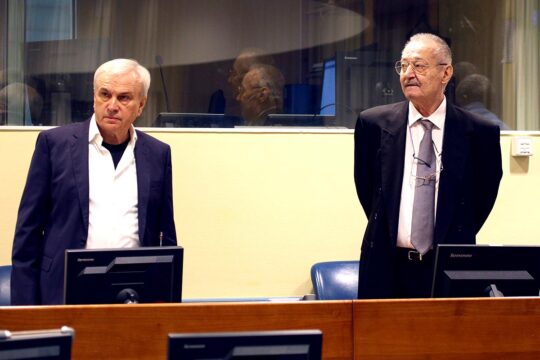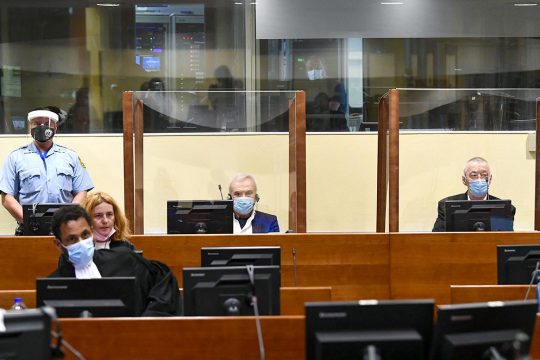Six leaders of a self-proclaimed statelet for Bosnian Croats, declared during the Balkan country's bloody 1990s conflict, hear a verdict Wednesday from UN judges on their appeal against war crimes convictions.
Here are details about their breakaway "republic", which they eventually hoped to merge with neighbouring Croatia:
- War breaks out -
When war broke out in Bosnia in 1992 as Yugoslavia fell apart, the country's Catholic Croats fought alongside Bosniak Muslims against Orthodox Serbs in the ethnically diverse country.
But the nationalist leaders of ethnic Croats, who made up about 17 percent of Bosnia's population of 4.4 million, gradually became more open about their desire to be part of a "Greater Croatia".
The project, backed by the nationalist Croatian president Franjo Tudjman, strained ties with Bosnian Muslims.
In May 1992, Bosnian Serb nationalist leader Radovan Karadzic and his Croat counterpart Mate Boban reached a deal that looked much like a partition of Bosnia at the expense of its Muslim people.
Sporadic clashes between Croats and Muslims eventually grew into bitter fighting between the former allies in 1993.
In August of that year, Boban proclaimed the "Croatian Republic of Herceg-Bosna".
The "republic" had a parliament, a government and a 50,000-strong army as well as independent financial structures. It also adopted the currency of neighbouring Croatia.
- Mostar bridge destroyed -
Croat separatists chose the southern city of Mostar, once a symbol of a multi-ethnic Bosnia, as their "capital".
Their forces controlled the west of the city and Bosnian Muslim forces controlled the east, nearly 80 percent of which was destroyed in the fighting.
The destruction of Mostar's Ottoman-era bridge by Croats in November 1993 became a symbol of the savagery of the war.
The Old Bridge, a World Heritage site, has been rebuilt since the war thanks to international financial assistance, including from Croatia.
In March 1994 a ceasefire agreement was reached in Washington between Croat and Muslim leaders, who founded the Muslim-Croat Federation.
This semi-independent entity still exists in Bosnia today, alongside the Serb-run Republika Srpska.
- War crimes charges -
Six leaders of the Bosnian Croat statelet -- which was formally dissolved in 1996 under international pressure -- were convicted in 2013 by the International Criminal Tribunal for the former Yugoslavia (ICTY).
They were found guilty of taking part in a scheme to remove Bosnian Muslims "permanently and create a Croatian territory" during the war, in which 100,000 people died.
Their sentences ranged from 10 to 25 years in jail.
The most senior among the group is Jadranko Prlic, 58, who served as prime minister of Hercog-Bosna.
Boban died in 1997.
- Statelet's legacy -
Dreams of more autonomy are still a live among Bosnian Croats.
In March 2001 they proclaimed a "temporary Croat autonomy", but the bid failed and the international community immediately sacked Bosnian Croat leader Ante Jelavic as a member of Bosnia's tripartite presidency.
After Catalonia recently proclaimed independence, graffiti appeared in Mostar, which remains deeply divided along ethnic lines, announcing that "Herceg-Bosna" will be the next to make the move.
Today Bosnian Croats seek to get their own federal unit, arguing that the country's Serbs have their own entity while Muslims dominate the federation.
The current Croat member of Bosnia's tripartite presidency, Dragan Covic, said recently that if Herceg-Bosna had not existed "it is hard to think that there would be Croat people" remaining in Bosnia.




